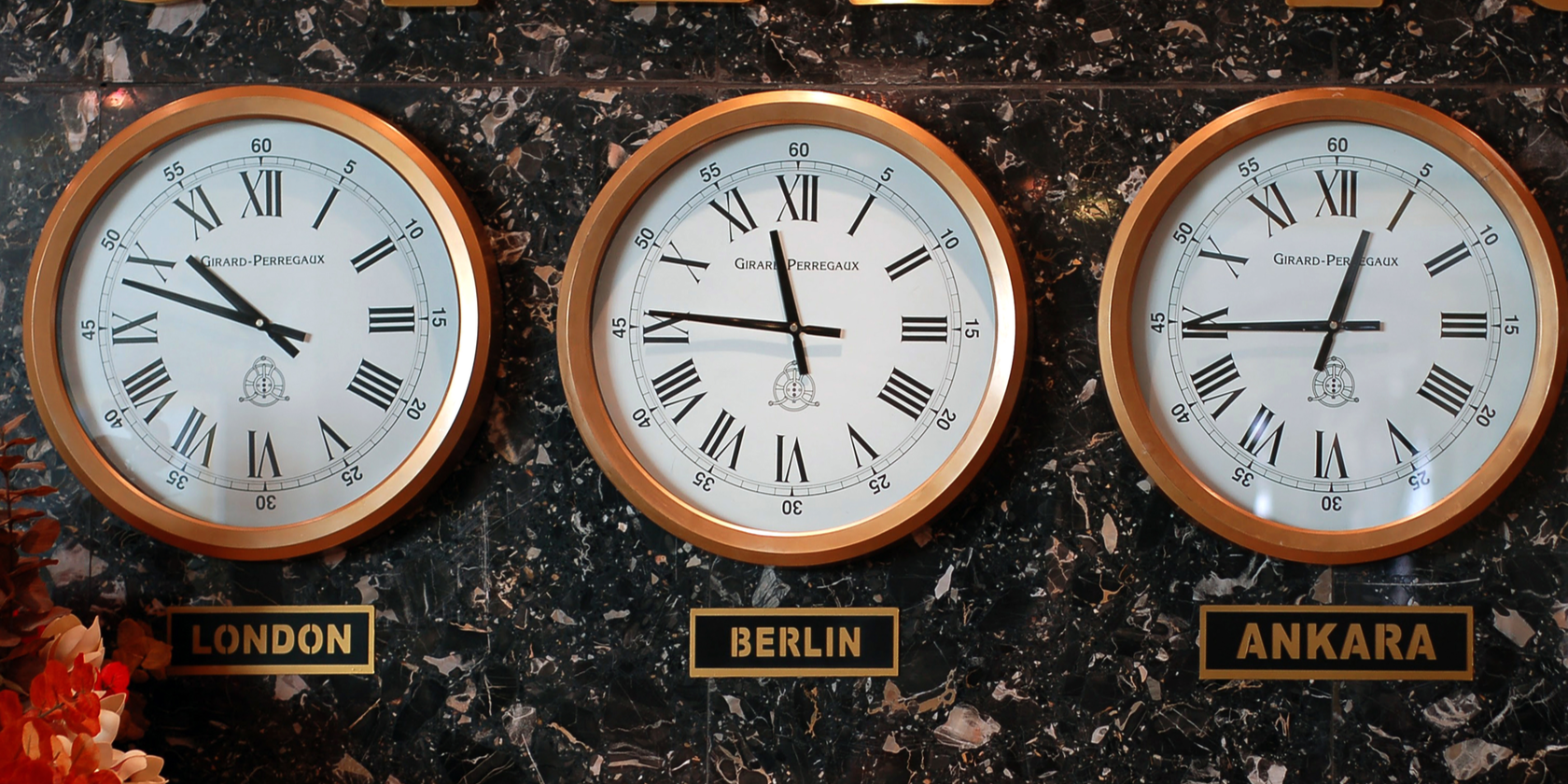If you’ve ever needed to check the time in a different time zone, chances are that you’ve heard of UTC. But what is this standard, why do we use it, and how does it come into play with computers?
Let’s dive into UTC so you can understand more about it and how it ties into everyday life with time zones.
What Is UTC?
UTC is the standard of time used all around the world to regulate clocks. It is effectively the “center” of our timekeeping, with all time zones referenced in relation to how far ahead of, or far behind, UTC they are.
The full name for UTC is Coordinated Universal Time, and its initialism was reached as a compromise. English speakers wanted to use CUT (for “Coordinated Universal Time”), while French speakers advocated for TUC (short for “temps universel coordonné”). Ultimately, UTC was chosen.
UTC vs. GMT: History
You’ll often see UTC and GMT used interchangeably, and while doing so can be suitable for informal use, they are not technically the same.
GMT, or Greenwich Mean Time, is a time zone located along the prime meridian. It was established as an international standard in 1884 at the International Meridian Conference, where many nations got together to decide what the prime meridian of the Earth would be. Prior to this, time varied wildly in different areas.
The prime meridian selected at that conference runs through the Royal Observatory in Greenwich, giving the time zone its name. From 1884 until the 1950s, GMT was used as the time standard.
However, as atomic clocks were invented in the 1950s, there were more accurate ways of keeping time than the solar time (calculating time based on the Sun) previously used. The new standard for coordinated time was first used at the beginning of 1960, but it didn’t become an official term until 1967 and replaced GMT a few years later.
So GMT is a time zone, while UTC is a time standard. You can consider UTC the successor to GMT, as it’s more accurate.
UTC Location and Offsets
UTC, like GMT, is based at the Prime Meridian. It does not change for any form of daylight saving time, and is usually communicated using a 24-hour clock to avoid confusion. It’s used as the primary time measurement by pilots—since they change time zones so quickly, referring to everything in UTC is less confusing.
Every other time zone is offset by a certain number of hours (sometimes half-hours or even 15-minute increments) from UTC. For example, Eastern Standard Time in North America is five hours behind UTC in the winter months. This is expressed as UTC-05:00 or UTC-5.
In areas that observe daylight saving time (called summer time in some regions), their relation to UTC changes in summer months. For instance, Eastern Daylight Time in North America is four hours behind UTC, since the clocks are moved one hour ahead for daylight saving time.
While the UK, Ireland, Portugal, and some countries in western Africa are aligned with UTC/GMT during the winter months, those that observe daylight saving time are one hour ahead of UTC in the summer months. They use a different time zone name, such as British Summer Time, to make this distinction.
The time zone that’s furthest ahead (the first to see a new year) is UTC+14. The Line Islands of Kiribati (east of Australia and south of Hawaii) are in this time zone. Meanwhile, the latest time zone (the last one to see a new year) is UTC-12. Only the uninhabited Baker Island and Howland Island are located in this time zone.
Most time zones are offset from UTC in one-hour increments, but this isn’t always the case. For instance, India Standard Time is UTC+05:30 and doesn’t change for daylight saving time. Nepal Standard Time is UTC+05:45, making it one of the few official time zones offset by 45 minutes.
How Do Computers Use UTC?
Obviously, every computer and smartphone today keeps track of the time. While you can set the clock manually, most devices check in with a time server to set the time on your device. Whether they use UTC or not depends on whether they’re based on Unix.
Windows is the only major OS to assume that your system’s clock is in local time. However, all Unix and Unix-like operating systems, including macOS, Linux, Android, and iOS, keep time in UTC and apply an offset.
The epoch, or start of timekeeping, for Unix is midnight UTC on January 1, 1970. Unix systems keep track of time by recording the number of seconds that have passed since this moment.
UTC is useful for everyday people scheduling events that involve participants in various time zones. You can add it to the world clock portion of the Clock app on both Android and iPhone. If you’re using a device that doesn’t support UTC as an option for some reason, Reykjavik time is the same as GMT and doesn’t change for daylight saving.
On Windows 10, you can go to Settings > Time & Language > Date & time and select Add clocks for different time zones on the right. Add UTC here, and you’ll see it on the time menu that appears when you click the clock at the bottom-right of your screen.
On a Mac, add UTC to the World Clock widget to make it easily accessible. And in Linux, the Clock app should have an option to add additional time zones.
Problems With UTC and Computer Time
Given that the “U” in UTC stands for “Universal,” you might think that using it is a perfect solution for all time needs. Unfortunately, this isn’t the case.
Leap Seconds
A big issue with UTC is that it has to add leap seconds every so often. This is because atomic time is not exactly the same as solar time, since the Earth’s rotation gradually slows down over time. Without leap seconds, UTC would eventually get further ahead of observable solar time.
Leap seconds are used so that UTC never differs from solar time by more than 0.9 seconds. A group called the International Earth Rotation and Reference Systems Service (IERS) is responsible for deciding when to insert leap seconds.
The first leap second happened in 1972, and there have been 37 in total. On average, a leap second occurs around every 21 months, but they aren’t consistent. During a leap second, clocks go from 23:59:59 to 23:59:60 before ticking over to 00:00:00 the next day.
Obviously, making up an extra second can cause a lot of problems with computing systems. Anything that relies on precise timing, or systems that aren’t built to account for the extra second, can have major issues when leap seconds occur. Unix time ignores leap seconds, meaning that this measurement is not 100 percent accurate.
Thus, there are ongoing discussions around stopping this practice.
Other Time Complications
Aside from this, UTC doesn’t explicitly account for many other changes in time that have happened over the years. For example:
- Time zones have been redrawn since their inception, so knowing what time it was in a specific location depends on how long ago you’re checking the time for.
- In the case of Samoa, an entire country changed time zones. It moved from UTC-11 to UTC+13 in 2011 in order to line up better with Australia and New Zealand.
- Some countries used to observe daylight saving time, but don’t anymore. And in some regions or states, part of the area might follow daylight saving, while others don’t. This means you need an exact location to determine the time.
- Most (but not all) of the world switched to the Gregorian calendar in the 1580s. Before this, the Julian calendar was used, which interprets dates differently.
These kinds of issues don’t affect you checking what time it is across the world right now, but they do show how time is not a static measure. Time is an extremely complex topic, and no matter how much we try to standardize it, there will always be exceptions and irregularities. These can be tough for computers to deal with.
We recommend Zach Holman’s article UTC is enough for everyone… right? if you’d like to learn more about the many complexities of measuring time.
UTC Is the Standard
Now you know what UTC is, why it’s the standard for measuring time, and how it’s implemented today. It’s important to know if you ever work with people in other time zones, but also interesting for its own sake.
Hopefully, it will be a long time before there’s another major time standard shakeup. In the meantime, you can at least make sure your computer’s time is accurate!
About The Author

